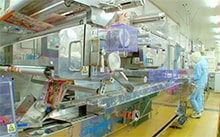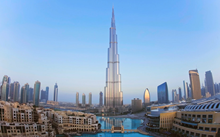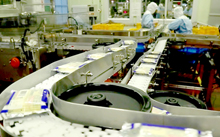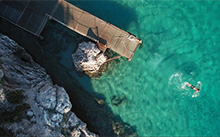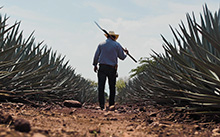The Environment Agency of Abu Dhabi is creating new habitats in remote desert regions in an effort to re-introduce the Arabian Oryx back into the wild. The Oryx has been extinct since 1972 in the UAE. A successful conservation program was launched in 1968, since then captive breeding efforts has increased the population to more than 4500, of which, most live on reserves. In 2007, a release program began to reintroduce the Arabian Oryx into a number of large protected areas where they can roam freely in their natural habitat. However, to sustain the Oryx, they need food, water and shade. Hitachi has built solar powered desalination plants to produce fresh water for the animals to drink and irrigate native plants.
The wildlife sanctuaries in the emirate of Abu Dhabi are located in barren regions with no permanent source of fresh water and negligible yearly rainfall. Providing a constant water supply to create suitable habitats for the Arabian Oryx was a big challenge facing the Environment agency of Abu Dhabi. There is water deep beneath the desert floor, but it has a very high salt content, which makes it unsuitable for drinking. Desalination plants would require electricity, and the nearest electrical installation is miles away.
In some areas we have a salinity of more than 60,000 ppm which is double the sea water salinity, so there were a lot of challenges facing us in the beginning and we had to plan it very carefully.
Dr Mohamed A Dawoud
Advisor, Water Resourcese
Environment Agency of Abu Dhabi
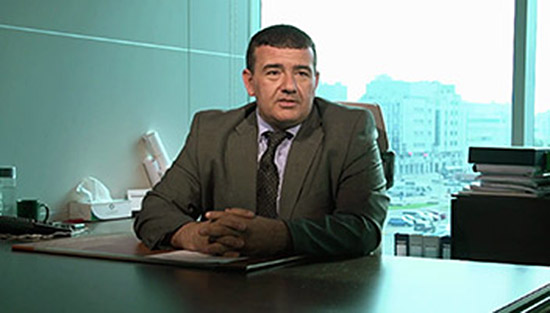
There is no lack of sunlight in the emirate of Abu Dhabi. Therefore, solar power mitigated the high cost of bringing electricity to such a remote location. An added bonus of the 300 square meters of solar collection panels as it has no adverse environmental impact on the wildlife sanctuaries.
The dilled wells in the area have a salinity ranging from brackish to saline, with upper limits of 35,000 ppm. Desalination is achieved via reverse osmosis technology, and harvesting the sun through photovoltaic panels powers these operations.
Each solar collection plant is self-contained, and maintained by a technician who visits regularly to monitor operations. The solar facility generates 45 kilowatts of renewable energy per hour that powers a desalination unit capable of producing 4 cubic meters of clean water per hour. There are 15 such plants, all identical in size and capacity
Hitachi is a well known company in Abu Dhabi and it works in many fields in Abu Dhabi. When we started this project Hitachi was invited like an other competitors and selection was very transparent.
Dr Mohamed A Dawoud
Advisor, Water Resourcese
Environment Agency of Abu Dhabi
The fresh water generated is pumped into a 600 meter long channel where animals come to drink. Additionally, each site is fitted with an evaporation pond where the brine reject, a by-product of reverse osmosis, is sent. After evaporation is complete, what is left is salt crystal that can be reconstituted for other uses.
In 2009 we started the first unit of solar RO. After that we installed the remaining fourteen RO solar units.
Hiroaki Koyano
Manager, Water Treatment Division
Hitachi, Ltd. Infrastructure Systems Company
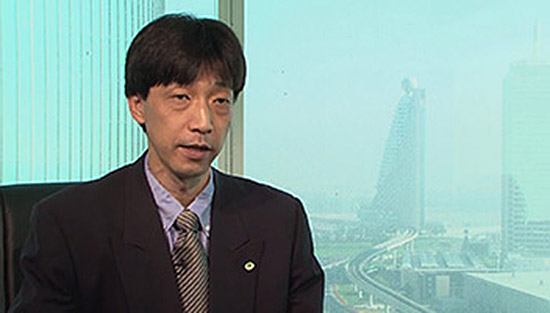
We understand that drinking water alone is not enough for the Arabian Oryx. The Oryx, along with other regional animals, also need food and shelter in order to survive and grow in numbers.
The idea of the project is to construct a water channel, filled with fresh water, and let the water circulate in the channel.
Dr Bassem Osman
Manager, Middle East Sales Department,
Hitachi, Ltd. Infrastructure Systems Company

But the big need for animals also, in the middle of the desert, is trees and shade so, we have quite a complex irrigation system.
James Hilyard
Unit Head, Infrastructure
Environment Agency of Abu Dhabi
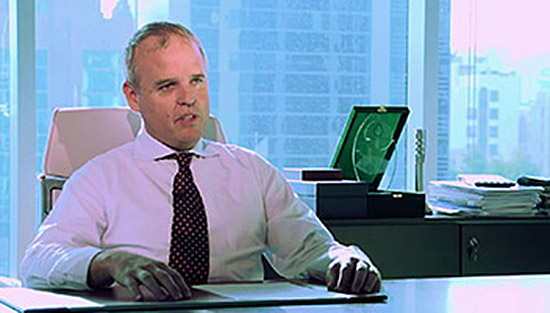
The solar desalination plants clean water on a three pronged approach; drinking water for animals, irrigation for plants that will create feed stock for the local wildlife and water for the growth of trees large enough to provide shade for the Arabian Oryx and others.
The 15 solar powered desalination plants built by Hitachi have aided in the reintegration of the Arabian Oryx back into the wild. Going forward the Environmental Agency of Abu Dhabi is looking to strength the numbers of other endangered desert species, in particular the Houbara Bustard, a large bird which is also being reintroduced.
Hitachi is proud to support The Environment Agency of Abu Dhabi on such a worthy endeavor. The agency was created to manage the environment of the Emirate and to implement national environmental laws. It aims to protect the natural wealth of the Emirate and promote sustainable development.
This gives us a good economic and environment friendly solutions and has no environmental impact like emissions or using diesels.
Dr Mohamed A Dawoud
Advisor, Water Resourcese
Environment Agency of Abu Dhabi
We hope to develop some of the sites into areas where people can come and look through a series of wildlife hides and see animals in their native habitat.
James Hilyard
Unit Head, Infrastructure
Environment Agency of Abu Dhabi
The Environment Agency of Abu Dhabi was created to manage the environment of the Emirate and to implement national environmental laws. It aims to protect the natural wealth of the Emirate of Abu Dhabi and to promote sustainable development. It is also the authority for environmental and wildlife issues and manages the Arabian Oryx Release Program.
In the MENA region, water is one of life’s most precious resources and one of Hitachi’s key businesses. The company can supply complete water treatment systems, from research, to design, to construction, to handover.
Hitachi understands the need for the sustainable use of water, as deep consideration must be given to the resources we use. Water is the life blood of our world and must be cared for at every turn.
Solutions By: Hitachi, Ltd., Building Systems Business Unit
